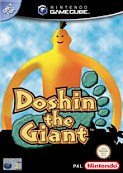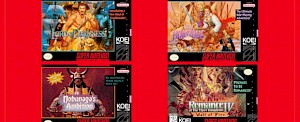News: Interview with Doshin creator
Posted 26 Feb 2002 at 20:14 by guest
The newest Famitsu Weekly in Japan has a pretty extensive interview with Iida-san, Doshin the Giant's creator. Here is PGC's exclusive translation of that interview:
Famitsu: The graphics of Kyojin no Doshin may have changed, but I believe the fun factor has not changed. The improvement on the graphics made the game much more enjoyable.
Iida: Yes. As development progressed, I could no longer see the DD version. I was very surprised also.
F: What is different about the game?
I: First of all, from the perspective of the gamer, the game has become easier to understand. After the DD version, we have received a lot of feedback. Taking that feedback into consideration, the game has in a way become closer to the player.
F: So you think that the DD version was hard to understand?
I: Hmmm, well, at that time, DD was a special piece of hardware. Maybe you could say that when releasing a game, there's always that nervousness and tension associated with it. Or it's that you have that feeling of "if it can be done, then let's do it!"
F: That isn't something a game creator often says.
I: Last time it was like a challenge in that if the players would accept a new innovating and interesting idea. This time, we have listened to what the gamers had to say, and really developed this game with affection. Game development was driven by our theme of simplicity. Therefore, the game became simpler and simpler.
F: Then would it be appropriate to say that the difficulty of the game dropped?
I: No. instead the difficulty level has risen.
F: I see.
I: Mainly gamers said that the game's objective was very hard to understand. As a result, we really worked on making the objective clear. Specifically, the objective of having the island inhabitants build monuments appears repeatedly early in the game. If necessary, we may even write it on the package.
F: When it was determined to release Doshin on the GameCube, what was your position regarding the port?
I: In the beginning, we were looking to simply port it over. We didn't intend to spend too much effort. (Laugh.) But at one point, we decided not to simply do a port.
F: What prompted this change?
I: In the early stages of development, we put screenshots of the GameCube version and DD version side by side. We saw that in GameCube's version we could see really far out - we could display the horizon clearly. So at that point, we decided to redo all the graphics.
F: So you were inspired by GameCube's power?
I: Yeah. That is a very big reason. And then, this time we developed the game with an English programmer (Editor's note: Giles Goddard). He had a lot of influence. We gave him the building blocks of the game, the original data, and we let him assemble the game. We were eagerly anticipating the results. The gap between us was very interesting; it was kind of like exchanging diaries.
F: Can you explain that a bit more concretely?
I: For example, one day I sent him the data for fish. On the next day when I got the data back, I loaded it and saw the fish with incredibly good movements. Even though we didn't ask for any changes on the movements. We were very surprised. Another time, birds dived into the ocean to eat the fish. Even more, when the bird eats the fish, it grows bigger. We never instructed him to do so.
F: Just like that?
I: It's all his idea. Additionally, if you stay still for a while, the bird's head will stop moving, and you could capture it more easily.
F: Really?
I: Yes. When we realized this, we asked him, "You did this right?" And he replied, "How did you find out?" (Laugh) That is very interesting.
F: That's amusing.
I: You bet. It could get tough when you are working with someone on a different wavelength. As for him, every time we're steered toward a better direction. I really think we have chemistry.
F: On the topic of game contents, it is basically following the DD version with extra features, correct?
I: You bet. The story has become relatively easier to understand. The ending in the previous version was very vague, but this time we have made it a bit more clear. We even put in movies. That is right, there are movies.
F: We saw it. (Laugh)
I: It was the first time for me to use movies.
F: How was it?
I: Yeah. I didn't even come close to Final Fantasy.
F: (laugh)
I: I came to understand that making movies was a very troublesome task.
F: You bet. When we saw the opening movie, we were very surprised. The appearance of the inhabitants was improved very much. It portrayed just one aspect of the daily lives of the inhabitants. We thought to ourselves, "Wow, you are showing this in the beginning." Did it require some courage or determination for this design choice? How did you decide to use that as the basis for the opening movie?
F: You are correct. We were very daring to show that in the beginning. When you begin the game, from the players' perspective, the inhabitants will always be small human beings. The opening was our first and last chance to let the players feel the emotion associated with the islanders. We wanted to appeal to players on the fact that in the beginning the inhabitants were normal human beings living normal lives.
F: It's like a double-edged sword.
I: Yes.
F: Some times you use the inhabitants as tools, and sometimes you step on them. You might forget the human side of these inhabitants. But for the same reason, it allows you to play freely. Was that a concept you proposed? I: The answer to this question is also the answer to why the DD version was hard to understand. This time we have made it clear that the objective for helping the inhabitants. But we also increased the destruction power of the giant.
F: That is very much like you. That is also why Doshin is so interesting. It could be said that if the theme was "Be nice to people!", there is a lot of unnecessary parts (like destroying stuff).
I: That is correct.
F: But it is the addition of those unnecessary elements that make the game so appealing.
I: That is also one of the game's themes - when you become big, there's bad things and good things. One way this is captured is seen through the existence of the yellow giant and the red giant. I mean, isn't it true that everyday we have a lot of feelings and emotions? After we finish building something with blocks, don't we go back and destroy it? As a result, we introduced the concept of destroying. Do we build it to destroy it? Or do we destroy it because we built it? Regarding these questions, we do not have an answer. That is up to the player to decide.
F: It is just exactly like its title, Doshin (perfect harmony).
I: Yes. Doshin is not about the freedom of doing this and doing that, but rather to be able to express your emotions freely. Well, basically what it boils down to is that there are only 2 types of emotions.
F: That concept of duality is sprinkled throughout the game.
I: I didn't intend to emphasize on the duality concept (i.e. good and evil). But since the movie Onmyoji (a Japanese exorcist (good) who fights demons and monsters (evil)) did fine here, it's all good I guess.
F: So this time, it's not a release on a specialized hardware, but a typical big release. What are your feelings?
I: Well, of course I feel very happy, and nervous. But maybe more scared than nervous.
F: You bet. By the way, "Kyojin no Doshin Kaihou Senzen Chibikko Dai Shyugou" (a movie) included on the extra disk of the DD version, will that be included in the GameCube version?
I: Yes, I remember now. It was a movie all right, although it's black and white.
F: Are we able to see that movie? Wait a minute, then that means you made movies before?
I: Unfortunately, we will not have it in the GameCube version.
F: Thank you very much.
























